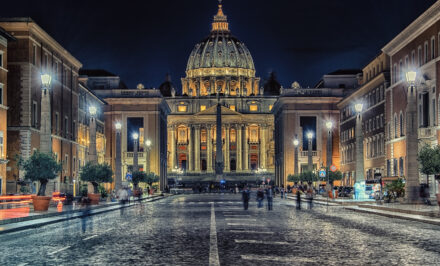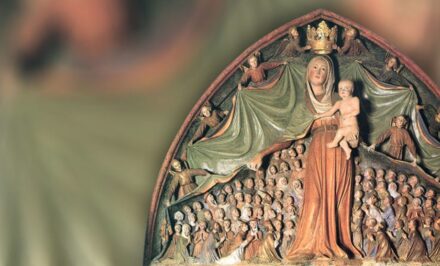 Fr. Javier Arteaga. Last September 15th was the 43rd anniversary of Father Kentenich’s death. Those who have visited his tomb in Schoenstatt always recall the prayerful atmosphere, the austerity of the place and the phrase on his tomb which summarizes his life: Dilexit Ecclesiam (He Loved the Church).
Fr. Javier Arteaga. Last September 15th was the 43rd anniversary of Father Kentenich’s death. Those who have visited his tomb in Schoenstatt always recall the prayerful atmosphere, the austerity of the place and the phrase on his tomb which summarizes his life: Dilexit Ecclesiam (He Loved the Church).
As a priest of Christ, Father Kentenich loved the Church in each moment of his life, following what St. Paul teaches: “Christ loved the church and gave his life for her” (EPH 5, 25-26). A love lived – from faith and fidelity, service, work and sacrifice, dialogue, dissent and search for the truth, forgiveness and reconciliation, pain and joy – surrenders daily to a real and concrete “you” which is the Church and not an idea from a desk. “Dilexit Ecclesiam, love for the Church also now motivates us to love with infinite warmth this Church which persecuted us…..to forget the past and to surrender all our strength so the Family can fulfill its mission of helping the Church to arrive victoriously to the newest shores.” (Conference of December 24, 1965)
Slowly, as fruitfulness of the experiences in the Schoenstatt Family – in two World Wars and in a world amidst great changes and constant development – growing in Father Kentenich was an image of Church with very definite traits which coincided with the definition which the Church has of itself in the Second Vatican Council. He would say at the end of his life: “Since 1912 or at least since 1914, we wanted nothing else – at the beginning being intuitive with a certain darkness and as time passed with more clarity – than what the Second Vatican Council has recognized as mission of the Church.” (Conference in Munster, December 1965). The vision of the Church at the newest shores
Father Kentenich adhered to the vision of the Church made by the Council in the dogmatic Constitution “Lumen Gentium” and in the pastoral Constitution “Gaudium et Spes.” In that council spirit, he described 5 characteristics of the Church – as he called it – “on the newest shores”:
1. A Church filled with the Holy Spirit
“First, the attitude should be to be disposed, without reserve, to the action of the Holy Spirit. Basic is that the Church exists in divine light, in divine confidence, in divine strength, and in divine security.” (Feb. 10, 1968)
2. A domestic Church
“It is a church strongly united in an extraordinarily profound brotherhood, but is simultaneously hierarchical, governed and led paternally.” (Rome, Dec. 8, 1965)
3. A pilgrim Church
“It is a Church which on the one hand is profoundly and intimately rooted in tradition, and on the other hand is extraordinarily free, unattached to antiquated forms…..For us, it is especially important that the Council uses preferentially the expression: ‘the church experiences itself as a Pilgrim Church, not as a Church already completed, enclosed in itself, but as a pilgrim Church.”’ (Rome, Dec. 8, 1965; Conference LG # 48)
4. A Church with characteristics of Mary
“The Blessed Virgin is image, model of the Church, because both are mothers, intimately united in that which creates the function they fulfill and in their fruitfulness. (…..) The Blessed Virgin is a model of the Church. St. Agustine has taught this literally and repeatedly, highlighting that the Blessed Virgin is the most perfect member of the Church.” (Dec. 27, 1964)
5. A poor and humble Church
“The Church has to become evermore a poor Church, a Church who loves poverty for itself, a Church which frees itself from all pomposity, a Church which will also be a friend to the poor and does not beg for the help or approval of the State” (Feb. 10, 1968; Conf. LG # 42-43). “An humble Church, sinful. It is worth saying that it is a Church which admits it is capable of sinning, a Church which may also be free and sincere, that asks for pardon and forgiveness for all the sins it has committed throughout the centuries.” (Feb. 17, 1968)
6. A Church inspiring the world
“It is a Church which has the mission to be the soul of the culture for the present and future world” (Dec. 8, 1965). “Not fleeing the world, nor a disorderly search for the world either….. The Church should penetrate the world, it should be the soul of the world.” (Feb. 10, 1968; Conf. GS # 36)
Children and heirs of the Father
In this sense, I was very happy to read recently the biographical sketch by Cardinal Bergoglio on Bishop Zaspe, calling him “bishop prophet.” He, as father and pastor, also loved the Church, giving his life for it. The Cardinal says: “He held to the Gospel, to the beatitudes. As someone said of him: when many fearful ones who sought to acquiesce remained silent, he spoke. And when these same ones – once the danger had passed – were motivated to speak, he remained silent. Prophet! He never spoke from the perspective of politics; never from social articulation, but from the Gospel, bringing light to the social situation.” (La Nación, Sept. 9, 2011)
Dear brothers and sisters, we are children and heirs of Father Kentenich. Let us not keep his legacy fearfully and stingily. Let us not repeat his words like parrots. Let us not “freeze” the prophetic dynamism of his charism. On the contrary, let us see to it that it multiplies itself and bears much fruit. Let us translate it and creatively apply it in the concrete challenges we must experience. Let us create in the power of the Covenant of Love and let us risk ourselves as he did, rowing toward the newest shores.
“All for Schoenstatt, Schoenstatt for the Church,
the Church for the world and the world for the Blessed Trinity”
Translation: Carlos Cantú, Schoenstatt Family Federation, La Feria, Texas USA 09212011













